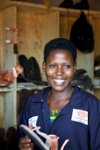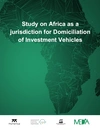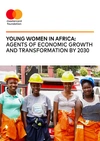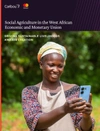Getting Ahead and Getting By: Exploring Outcomes of Youth Livelihoods Programs examines factors that influence young people’s earning opportunities and well-being. The research is based on the experiences of 130 young people participating in two programs supported by Learn, Earn and Save (LES), a Mastercard Foundation initiative that was established to test models for market-level training and opportunities.
Through the initiative, economically-disadvantaged youth from East Africa have received opportunities to:
- Learn: Technical and soft skills.
- Earn: Access to internships, apprenticeships, job placements, and opportunities to start small businesses.
- Save: Access to financial education, savings groups, and loans.
Learning and Livelihoods Trajectories
The research conducted by the University of Minnesota, the initiative’s learning partner, identified two learning and livelihood trajectories of participants:
- Getting ahead: Those who have made steady progress in their employment or self-employment and in attaining other goals.
- Getting by: Those who have struggled to leverage work or learning opportunities to improve their (or their families’) well-being or achieve other goals or aspirations.
These pathways suggest mediating factors that are explored further in this report:
- Gender: Gender was the most consistent and striking factor that influenced youth’s trajectories. Male youth were more likely to “get ahead,” while female youth were more likely to “get by.”
- Certification: Youth’s level of education or certification impacted their trajectories. Secondary school certification combined with programmatic supports opened up formal employment opportunities for youth, though some of these may have been causal or short-term contracts. Likewise, the opportunity to attain certification in specific trades provided validity to youth as they sought to start or enhance their own enterprises.
- Employment Sector: Youth in different employment sectors faced unique challenges that impacted their trajectories of “getting ahead” and “getting by.”
- Mixed Livelihoods Strategies: Youth frequently engaged in mixed livelihoods. While youth who were “getting ahead” engaged in mixed livelihoods by taking advantage of strategic opportunities, those who were “getting by” did so out of a need to make ends meet.
- Financial Services: Access to capital played a crucial role in youth’s ability to get ahead. Youth who worked in stable employment and had access to financial institutions or social resources were often able to utilize those at critical moments to facilitate business growth or to mitigate challenges.
- Social Networks: Family, community, and program-based networks played a complicated role in youth’s livelihoods. Social networks not only offered supports, financial and otherwise, but in turn became an avenue for youth to demonstrate their changing status within their family or community as they attempted to support others within their networks.
These insights can inform future planning and implementation of youth livelihoods programs, and will continue to inform our work under our Young Africa Works strategy.
About Learn, Earn and Save
The Mastercard Foundation established the Learn, Earn and Save initiative in 2011 to test different models for providing market-relevant training and opportunities to disadvantaged young people in East Africa to help them access jobs or start small businesses. In partnership with CAP Youth Empowerment Institute in Kenya, Fundación Paraguaya in Tanzania, and Swisscontact in Tanzania and Uganda, LES piloted three different approaches. From the outset, the University of Minnesota acted as a learning partner, tracking outcomes year-over-year so the models could be adjusted to better suit youth needs. The initiative drew to a close in 2016-2017. CAP YEI and Swisscontact, upon whose projects this publication focuses, have entered a phase of work in partnership with the Foundation.




